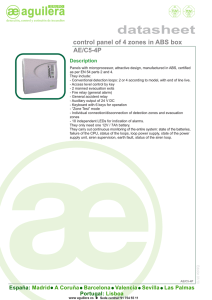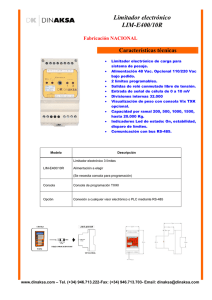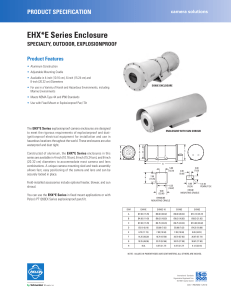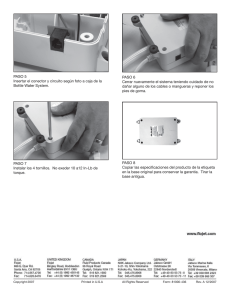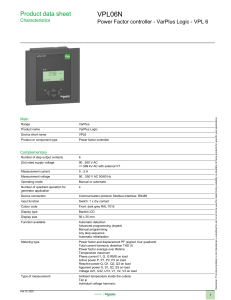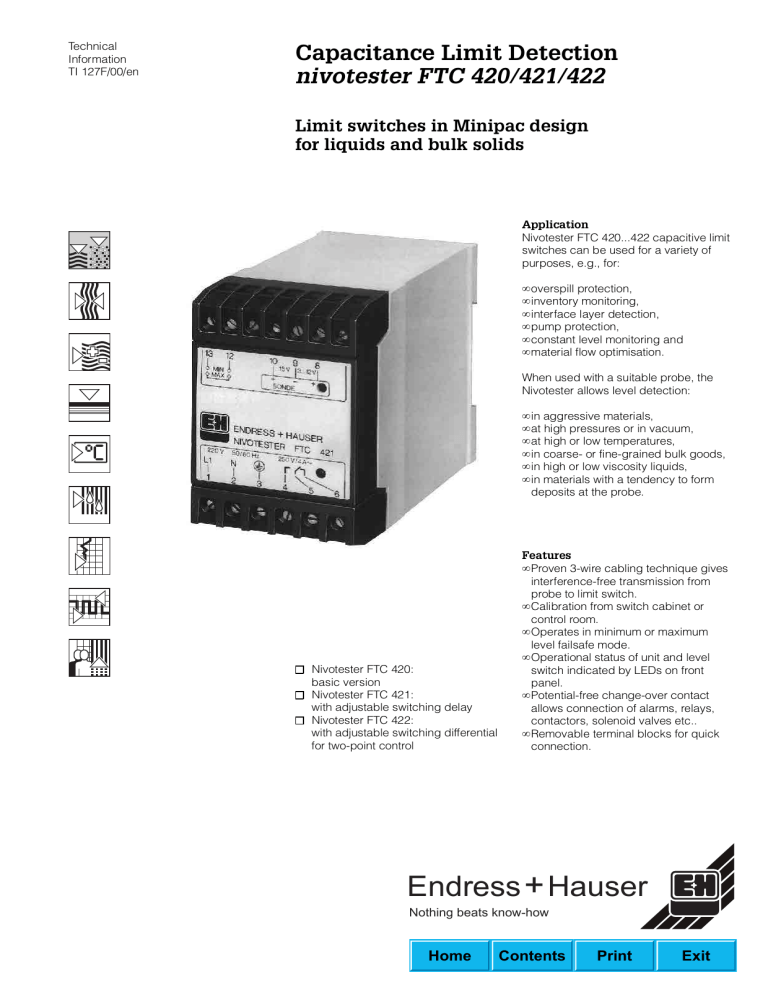
Technical Information TI 127F/00/en Capacitance Limit Detection nivotester FTC 420/421/422 Limit switches in Minipac design for liquids and bulk solids Application Nivotester FTC 420...422 capacitive limit switches can be used for a variety of purposes, e.g., for: • • • • • • overspill protection, inventory monitoring, interface layer detection, pump protection, constant level monitoring and material flow optimisation. When used with a suitable probe, the Nivotester allows level detection: • • • • • • Nivotester FTC 420: basic version Nivotester FTC 421: with adjustable switching delay Nivotester FTC 422: with adjustable switching differential for two-point control in aggressive materials, at high pressures or in vacuum, at high or low temperatures, in coarse- or fine-grained bulk goods, in high or low viscosity liquids, in materials with a tendency to form deposits at the probe. Features • Proven 3-wire cabling technique gives interference-free transmission from probe to limit switch. • Calibration from switch cabinet or control room. • Operates in minimum or maximum level failsafe mode. • Operational status of unit and level switch indicated by LEDs on front panel. • Potential-free change-over contact allows connection of alarms, relays, contactors, solenoid valves etc.. • Removable terminal blocks for quick connection. Endress + Hauser Nothing beats know-how Home Contents Print Exit Measuring System Function The probe and container act as a capacitor, the capacitance of which is dependent upon the level of liquid or solids present. The electronic insert, usually mounted in the probe head, passes a level-proportional voltage signal to the Nivotester for evaluation. This actuates the output relay when the preset level is violated. The resulting signal can be used to drive an annunciator, actuator or further relay. A bridge on the terminal block sets the the output relay to act in minimum or maximum fail-safe mode. The switching status of the relay is indicated at the front panel by a red, the operational status by a green LED. On power failure both LEDs extinguish – the output relay de-energises. FTC 420 FTC 421 FTC 422 e.g. Max. A typical measuring system comprises: • the Nivotester FTC 420, 421 or 422, • the EC 61 Z electronic insert and • a probe, suitable for the medium to be measured (for FTC 422 one ① or two ② for two-point control). e.g. Max. e.g. Min. 2 2 Mounting The Nivotester limit switches use Minipac housings with snap-on fastenings suitable for switch cabinet installation on a symmetrical (top hat) rail. Installation Spacing The units can be mounted flush to each other provided the operating temperature does not exceed 50 °C. For ambient temperatures of 60 °C, a gap of 10 mm must be left between adjacent units. The vertical spacing must exceed 15 mm. Protective Housing IP 55 A protective housing with transparent cover, accommodating two units, is available for field installation. Row-mounting on a top hat rail Protective housing IP 55 Electrical Connection The Nivotester and electronic insert are connected by a 3-wire screened installation cable: two wires supply direct current to the insert, the third carries a voltage signal (3…12 V) proportional to the capacitance of the probe back to the unit. • A bridge can be inserted between terminals 1 and 2 of the electronic insert when there is a tendency for conductive build-up to form on the probe. • The fail-safe mode is controlled by a bridge between terminals 12 and 13. • The potential-free change-over contact is located at terminals 4, 5 and 6. The evaluation circuit is isolated from the power supply by a transformer and from the output circuit by a potential-free relay. With bridge: Without: Max.-fail-safe mode Min.-fail-safe mode Nivotester FTC 420/421/422 Bridge for build-up at probe (FTC420, FTC 421) or two-point control Second probe for Nivotester FTC 422 Coaxial cable When the Nivotester FTC 422 is used with two probes, the second probe is used without electronic insert and the connection is made between probe ground and core via a coaxial cable. Terminals 1 and 2 of the insert are short-circuited. Shielding Output relay Core Power supply 3 Technical Data Mechanical • Housing: Minipac housing in light grey plastic, front panel blue. Protection: IP 40 • Dimensions (l x b x h): 113 mm x 50 mm x 75 mm • Weight: approx. 0.3 kg. • Mounting rail: EN 50022-35x15 or EN 50022-35x7.5 Ambient Temperature • Permissible temperature: –20…+60 °C (single instrument), –20…+50 °C (multiple instruments), –25…+80 °C (storage). Top hat rail Dimensions for cabinet mounting [mm] The device fulfils the legal requirements of the following EC Guidelines: Guideline 89/336/EC (Electromagnetic compatibility), Guidelines 73/23/EC and 93/68/EC (Low Voltage Appliances). Electrical Connection • Terminals: Removable terminal block, black, 1 x 6-pole, 1 x 7-pole, Protection: IP 20. • Wire cross-section: 1 x 0.5 mm2 to 1 x 2.5 mm2 or 2 x 0.5 mm2 to 2 x 1.5 mm2. • Without terminals: Flat plug 0.8 x 6.3 as per DIN 46244. • Power supply: 200 V…240 V 50/60 Hz +15 % -10 % 100 V…127 V 50/60 Hz +15 % -10 % 42 V… 48 V 50/60 Hz ±15 % 24 V 50/60 Hz ±15 % 20 V… 30 V d.c. • Power consumption: ca. 3 W (4 VA). • Electrical isolation: Transformer between power supply and evaluation circuit. Relay between evaluation circuit and output circuit. Electromagnetic compatibility (EMC): Immunity to EN 50082-1. Emission to EN 50081-1. Adjustable Probe Capacitance • Hook switch CE Mark For general information on electromagnetic compatibility (test methods, installation hints) see TI 241F/00/e. Range I II III Capacitance ca. 10… 100 pF ca. 80… 180 pF ca. 160… 350 pF Input voltage ca. 3… 6.6 V ca. 6… 8.8 V ca. 8.2… 12 V • Switching delay for FTC 421: 0…20 s. • Hysteresis for FTC 422: Separate control, ranges as above. Outputs • Output signal: Potential-free change-over contact, selectable maximum or minimum fail-safe mode. • Switching capacity: max. 250 V a.c., max 6 A, max. 1500 VA, cos ϕ = 1 max. 750 VA, cos ϕ ≥ 0.7, max. 250 V d.c., max.6 A, max. 200 W. • Operational display: Green LED lights. • Relay switching status: Red LED lights when de-energised. • Response time: 0.2 s, for FTC 421 adjustable 0…20 s. • Short-out time on power failure: approx. 0.3 s. Electronic Insert • Housing: Plastic, cast resin electronics, Protection: IP 55. • Terminals: Protection: IP 00. • Connection: 3-core screened cable. • Permissible ambient temperature: –20…+100 °C. • Frequency: approx. 500 kHz. • Power supply: 15 V from Nivotester FTC. • Output signal voltage: 3…12 V. • Weight: 130 g Protective Housing for FTC ... • Base: ABS • Front: Impact-resistant plexiglas, matt with transparent window, Protection: IP 55. • Cable glands: 5 x PG 16. • Dimensions (l x b x h): 124 mm x 160 mm x 164 mm. • Weight: 0.5 kg. • Permissible ambient temperature: –20…+50 °C; –20…+40 °C for two units. Subject to modification. EC 61 Z electronic insert. 4 Maximum and Minimum Fail-safe Mode Nivotester FTC 420/421 This instrument can be set to operate as a maximum or a minimum limit switch. For the Nivotester FTC 421 the switching can be delayed by up 20 s, e.g. to prevent spurious switching due to turbulance etc.. Minimum fail-safe mode The relay de-energises when the product drops below the switch point: the red LED lights. Maximum fail-safe mode: The relay de-energises when the switch point is exceeded: the red LED lights Power failure On a power failure both green and red LEDs extinguish: the relay de-energises. Nivotester FTC 422 This instrument provides two-point control with a maximum or minimum switch point and a switching differential (hysteresis). Minimum fail-safe mode The relay de-energises when the product drops below the switch point. The red LED lights and remains lit until the switching differential point is exceeded: the relay energises again. Maximum fail-safe mode: The relay de-energises when the switch point is exceeded. The red LED lights and remains lit until the product drops below the switching differential point: the relay energises again. Power failure On power failure both green and red LEDs extinguish: the relay de-energises. Example for minimum fail-safe mode, FTC 422 Level Relay status Max. LED status green lit Emptying Relay energised Min. green lit Max. Relay de-energised Min. Max. red lit green lit Filling Relay de-energised Min. red lit green lit Max. When the Nivotester FTC 422 is used to control the filling or emptying of a vessel, the red relay status LED indicates that the level is rising or falling. red extinguished Relay energised Min. 5 red extinguished Ordering Information Nivotester FTC 420 Power Supply A 200 VAC ... 240 VAC, 50/60 Hz B 100 VAC ... 127 VAC, 50/60 Hz C 42 VAC ... 48 VAC, 50/60 Hz D 24 VAC, 50/60 Hz E 20 VDC ... 30 VDC. Y Special version, please state FTC 420 N Nivotester FTC 421 Power Supply A 200 VAC ... 240 VAC, 50/60 Hz B 100 VAC ... 127 VAC, 50/60 Hz C 42 VAC ... 48 VAC, 50/60 Hz D 24 VAC, 50/60 Hz E 20 VDC ... 30 VDC. Y Special version, please state FTC 421 Nivotester FTC 422 Power Supply A 200 VAC ... 240 VAC, 50/60 Hz B 100 VAC ... 127 VAC, 50/60 Hz C 42 VAC ... 48 VAC, 50/60 Hz D 24 VAC, 50/60 Hz E 20 VDC ... 30 VDC. Y Special version, please state FTC 422 Supplementary Documentation Electronic Insert EC 61 Z Technical Information TI 267F/00/en Separate housing for electronic insert Technical Information TI 228F/00/e System Components Minipac Technical Information TI 009F/00/e Endress+Hauser GmbH+Co. Instruments International P.O. Box 22 22 D-79574 Weil am Rhein Germany Tel. (0 76 21) 9 75-02 Tx 7 73 926 Fax (0 76 21) 9 753 45 http://www.endress.com Endress + Hauser Nothing beats know-how 10.97/MTM TI 127F/00/en/10.97 EHF/CV4.2


